Healthcare Assignment: Storage and Retention Recommendations
VerifiedAdded on 2022/09/05
|6
|1300
|52
Report
AI Summary
This report addresses the challenges of healthcare records management, focusing on storage and retention policies within a large healthcare organization. The paper begins with an introduction to health information management and its importance in healthcare, highlighting the need for effective data handling. The core of the report offers detailed recommendations on record storage, advocating for solutions that address space limitations and improve access while ensuring patient privacy and data security. The recommendations cover the use of appropriate storage systems, encryption, and wireless security networks, with a focus on training for healthcare professionals. The report also provides a detailed retention policy and procedure, emphasizing the importance of data integrity, authenticity, and compliance with provincial legislative requirements. By implementing these recommendations, healthcare facilities can improve data management, enhance patient care, and maintain compliance with relevant regulations. The paper concludes by reiterating the importance of healthcare data management and the need for continuous improvement in security and safety measures, summarizing the key recommendations for effective healthcare data management.
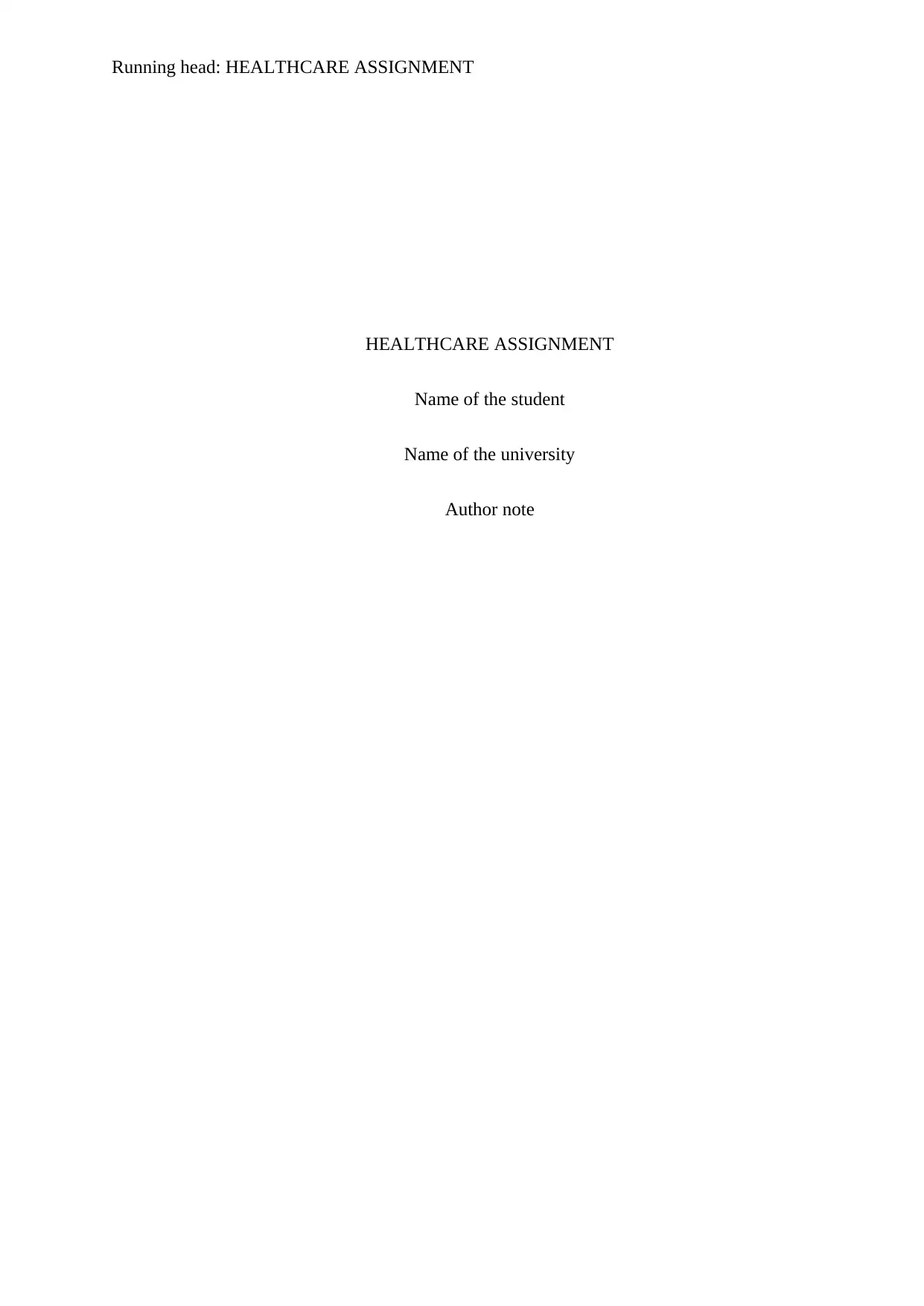
Running head: HEALTHCARE ASSIGNMENT
HEALTHCARE ASSIGNMENT
Name of the student
Name of the university
Author note
HEALTHCARE ASSIGNMENT
Name of the student
Name of the university
Author note
Paraphrase This Document
Need a fresh take? Get an instant paraphrase of this document with our AI Paraphraser
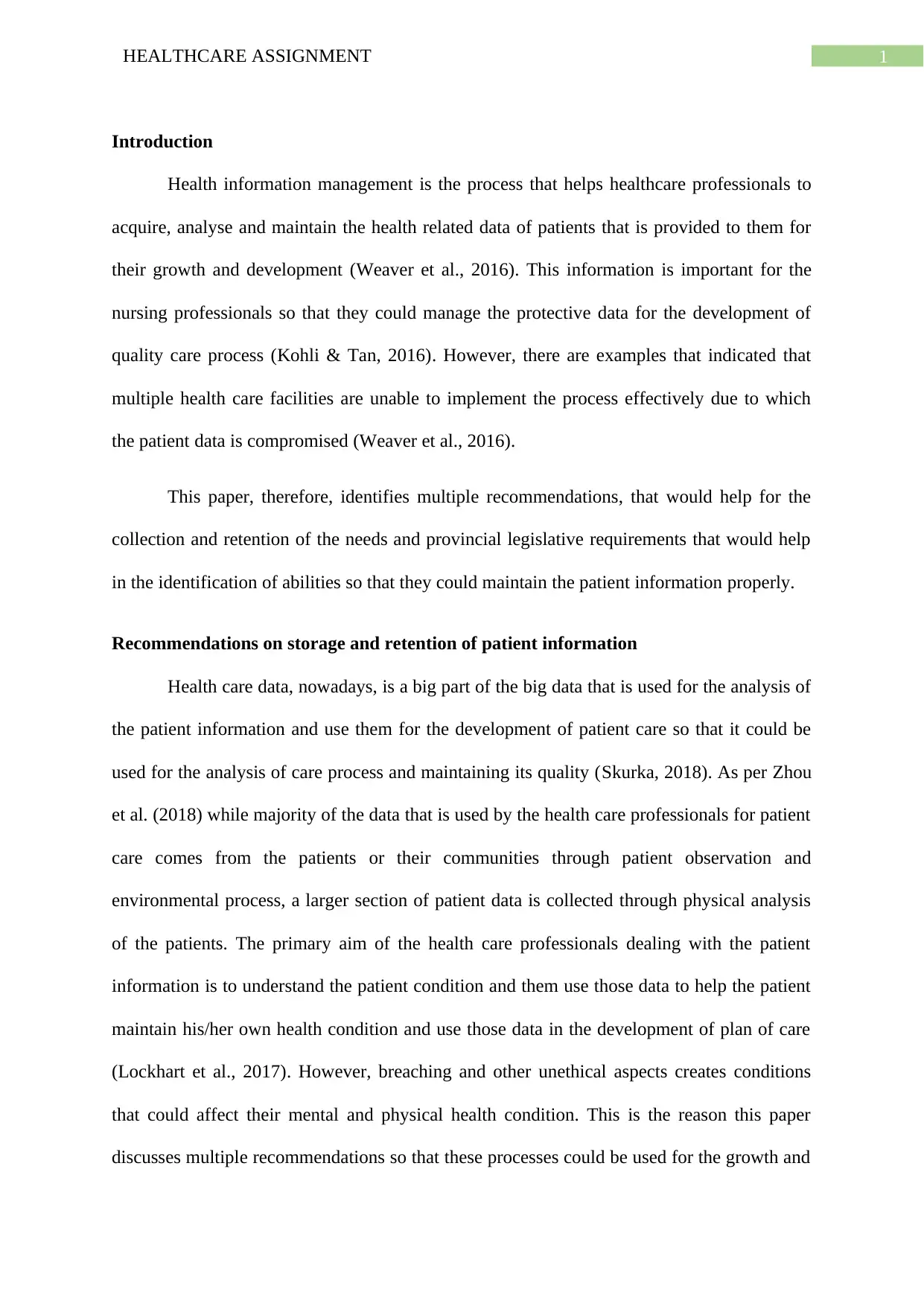
1HEALTHCARE ASSIGNMENT
Introduction
Health information management is the process that helps healthcare professionals to
acquire, analyse and maintain the health related data of patients that is provided to them for
their growth and development (Weaver et al., 2016). This information is important for the
nursing professionals so that they could manage the protective data for the development of
quality care process (Kohli & Tan, 2016). However, there are examples that indicated that
multiple health care facilities are unable to implement the process effectively due to which
the patient data is compromised (Weaver et al., 2016).
This paper, therefore, identifies multiple recommendations, that would help for the
collection and retention of the needs and provincial legislative requirements that would help
in the identification of abilities so that they could maintain the patient information properly.
Recommendations on storage and retention of patient information
Health care data, nowadays, is a big part of the big data that is used for the analysis of
the patient information and use them for the development of patient care so that it could be
used for the analysis of care process and maintaining its quality (Skurka, 2018). As per Zhou
et al. (2018) while majority of the data that is used by the health care professionals for patient
care comes from the patients or their communities through patient observation and
environmental process, a larger section of patient data is collected through physical analysis
of the patients. The primary aim of the health care professionals dealing with the patient
information is to understand the patient condition and them use those data to help the patient
maintain his/her own health condition and use those data in the development of plan of care
(Lockhart et al., 2017). However, breaching and other unethical aspects creates conditions
that could affect their mental and physical health condition. This is the reason this paper
discusses multiple recommendations so that these processes could be used for the growth and
Introduction
Health information management is the process that helps healthcare professionals to
acquire, analyse and maintain the health related data of patients that is provided to them for
their growth and development (Weaver et al., 2016). This information is important for the
nursing professionals so that they could manage the protective data for the development of
quality care process (Kohli & Tan, 2016). However, there are examples that indicated that
multiple health care facilities are unable to implement the process effectively due to which
the patient data is compromised (Weaver et al., 2016).
This paper, therefore, identifies multiple recommendations, that would help for the
collection and retention of the needs and provincial legislative requirements that would help
in the identification of abilities so that they could maintain the patient information properly.
Recommendations on storage and retention of patient information
Health care data, nowadays, is a big part of the big data that is used for the analysis of
the patient information and use them for the development of patient care so that it could be
used for the analysis of care process and maintaining its quality (Skurka, 2018). As per Zhou
et al. (2018) while majority of the data that is used by the health care professionals for patient
care comes from the patients or their communities through patient observation and
environmental process, a larger section of patient data is collected through physical analysis
of the patients. The primary aim of the health care professionals dealing with the patient
information is to understand the patient condition and them use those data to help the patient
maintain his/her own health condition and use those data in the development of plan of care
(Lockhart et al., 2017). However, breaching and other unethical aspects creates conditions
that could affect their mental and physical health condition. This is the reason this paper
discusses multiple recommendations so that these processes could be used for the growth and
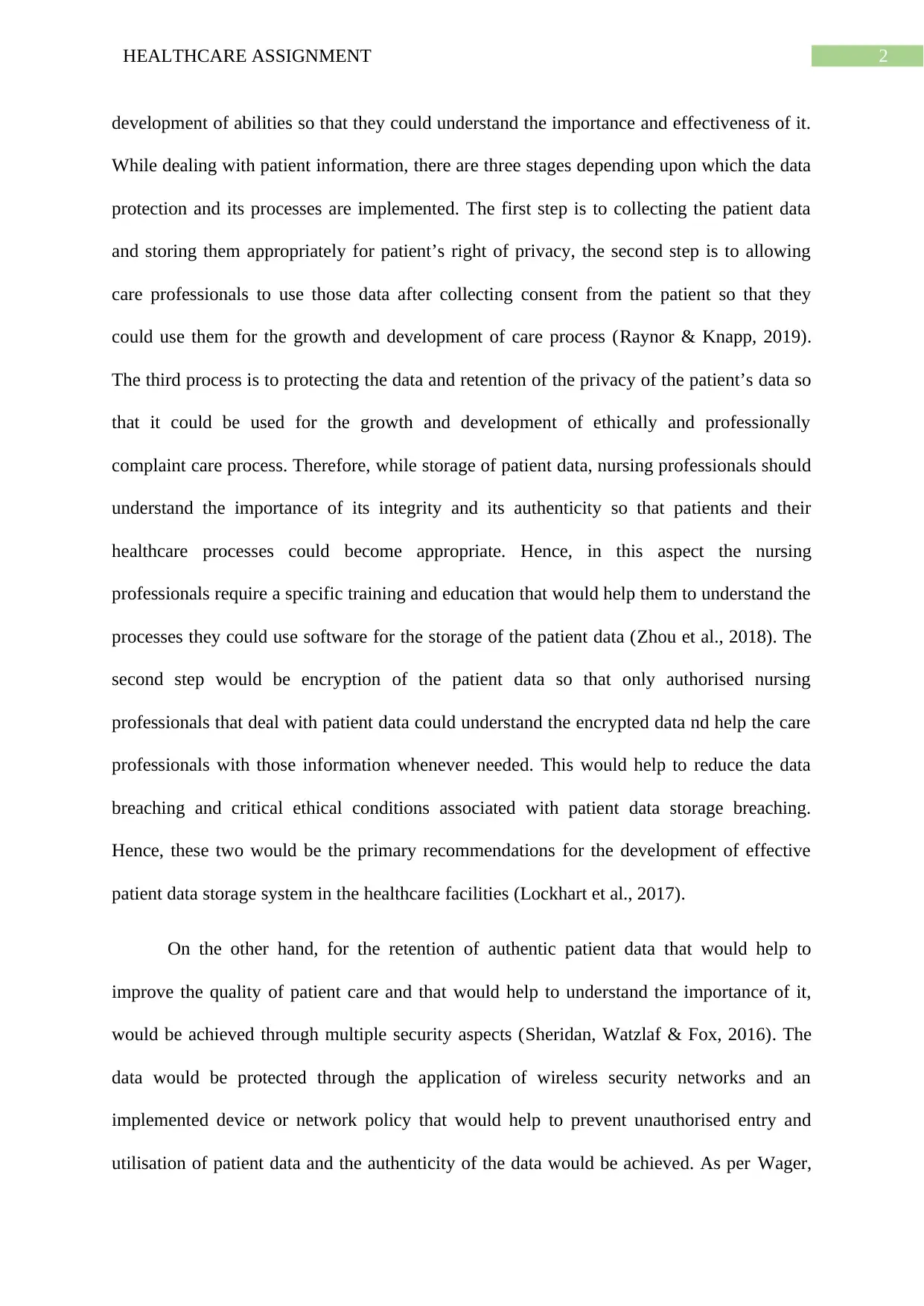
2HEALTHCARE ASSIGNMENT
development of abilities so that they could understand the importance and effectiveness of it.
While dealing with patient information, there are three stages depending upon which the data
protection and its processes are implemented. The first step is to collecting the patient data
and storing them appropriately for patient’s right of privacy, the second step is to allowing
care professionals to use those data after collecting consent from the patient so that they
could use them for the growth and development of care process (Raynor & Knapp, 2019).
The third process is to protecting the data and retention of the privacy of the patient’s data so
that it could be used for the growth and development of ethically and professionally
complaint care process. Therefore, while storage of patient data, nursing professionals should
understand the importance of its integrity and its authenticity so that patients and their
healthcare processes could become appropriate. Hence, in this aspect the nursing
professionals require a specific training and education that would help them to understand the
processes they could use software for the storage of the patient data (Zhou et al., 2018). The
second step would be encryption of the patient data so that only authorised nursing
professionals that deal with patient data could understand the encrypted data nd help the care
professionals with those information whenever needed. This would help to reduce the data
breaching and critical ethical conditions associated with patient data storage breaching.
Hence, these two would be the primary recommendations for the development of effective
patient data storage system in the healthcare facilities (Lockhart et al., 2017).
On the other hand, for the retention of authentic patient data that would help to
improve the quality of patient care and that would help to understand the importance of it,
would be achieved through multiple security aspects (Sheridan, Watzlaf & Fox, 2016). The
data would be protected through the application of wireless security networks and an
implemented device or network policy that would help to prevent unauthorised entry and
utilisation of patient data and the authenticity of the data would be achieved. As per Wager,
development of abilities so that they could understand the importance and effectiveness of it.
While dealing with patient information, there are three stages depending upon which the data
protection and its processes are implemented. The first step is to collecting the patient data
and storing them appropriately for patient’s right of privacy, the second step is to allowing
care professionals to use those data after collecting consent from the patient so that they
could use them for the growth and development of care process (Raynor & Knapp, 2019).
The third process is to protecting the data and retention of the privacy of the patient’s data so
that it could be used for the growth and development of ethically and professionally
complaint care process. Therefore, while storage of patient data, nursing professionals should
understand the importance of its integrity and its authenticity so that patients and their
healthcare processes could become appropriate. Hence, in this aspect the nursing
professionals require a specific training and education that would help them to understand the
processes they could use software for the storage of the patient data (Zhou et al., 2018). The
second step would be encryption of the patient data so that only authorised nursing
professionals that deal with patient data could understand the encrypted data nd help the care
professionals with those information whenever needed. This would help to reduce the data
breaching and critical ethical conditions associated with patient data storage breaching.
Hence, these two would be the primary recommendations for the development of effective
patient data storage system in the healthcare facilities (Lockhart et al., 2017).
On the other hand, for the retention of authentic patient data that would help to
improve the quality of patient care and that would help to understand the importance of it,
would be achieved through multiple security aspects (Sheridan, Watzlaf & Fox, 2016). The
data would be protected through the application of wireless security networks and an
implemented device or network policy that would help to prevent unauthorised entry and
utilisation of patient data and the authenticity of the data would be achieved. As per Wager,
⊘ This is a preview!⊘
Do you want full access?
Subscribe today to unlock all pages.

Trusted by 1+ million students worldwide
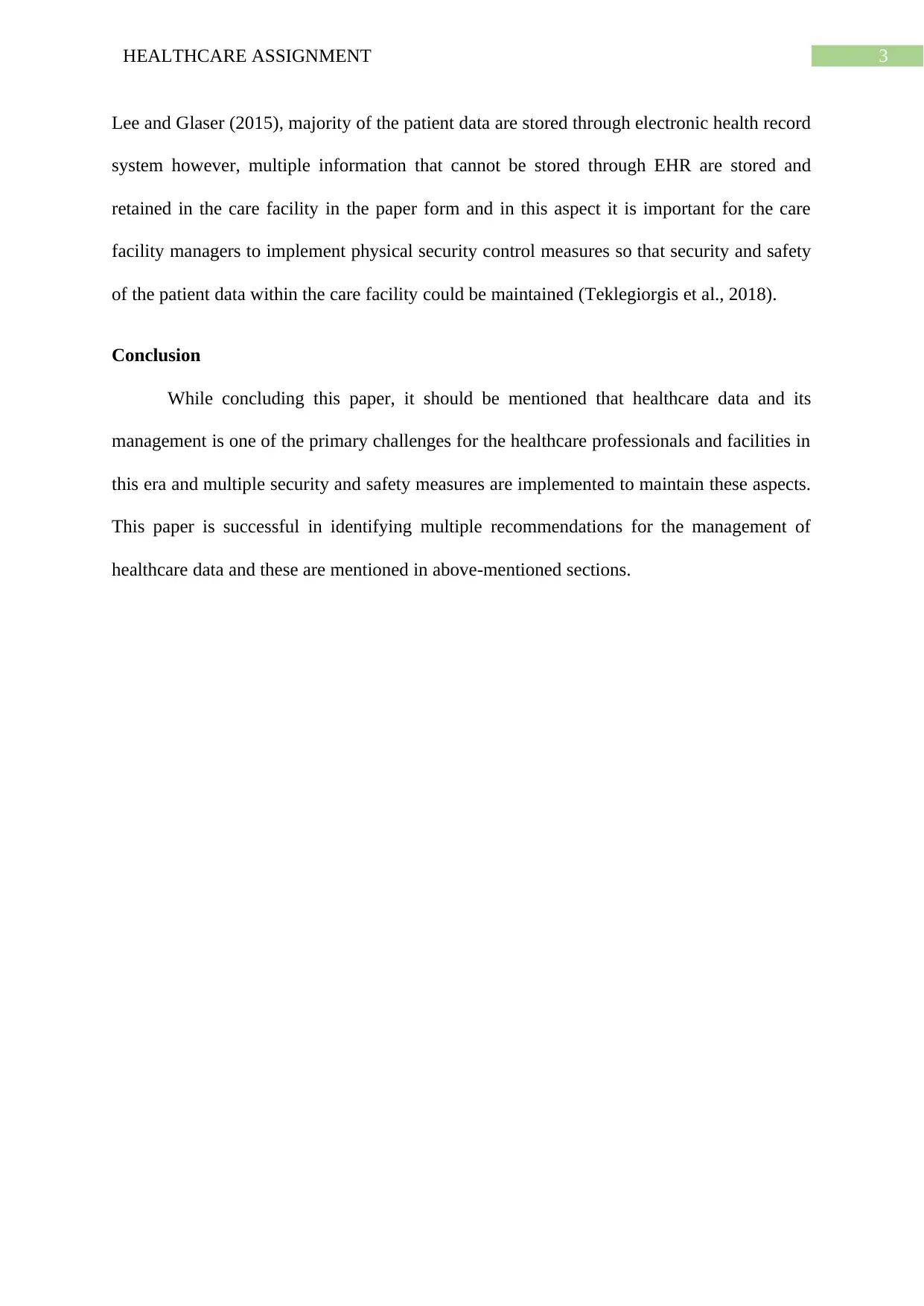
3HEALTHCARE ASSIGNMENT
Lee and Glaser (2015), majority of the patient data are stored through electronic health record
system however, multiple information that cannot be stored through EHR are stored and
retained in the care facility in the paper form and in this aspect it is important for the care
facility managers to implement physical security control measures so that security and safety
of the patient data within the care facility could be maintained (Teklegiorgis et al., 2018).
Conclusion
While concluding this paper, it should be mentioned that healthcare data and its
management is one of the primary challenges for the healthcare professionals and facilities in
this era and multiple security and safety measures are implemented to maintain these aspects.
This paper is successful in identifying multiple recommendations for the management of
healthcare data and these are mentioned in above-mentioned sections.
Lee and Glaser (2015), majority of the patient data are stored through electronic health record
system however, multiple information that cannot be stored through EHR are stored and
retained in the care facility in the paper form and in this aspect it is important for the care
facility managers to implement physical security control measures so that security and safety
of the patient data within the care facility could be maintained (Teklegiorgis et al., 2018).
Conclusion
While concluding this paper, it should be mentioned that healthcare data and its
management is one of the primary challenges for the healthcare professionals and facilities in
this era and multiple security and safety measures are implemented to maintain these aspects.
This paper is successful in identifying multiple recommendations for the management of
healthcare data and these are mentioned in above-mentioned sections.
Paraphrase This Document
Need a fresh take? Get an instant paraphrase of this document with our AI Paraphraser
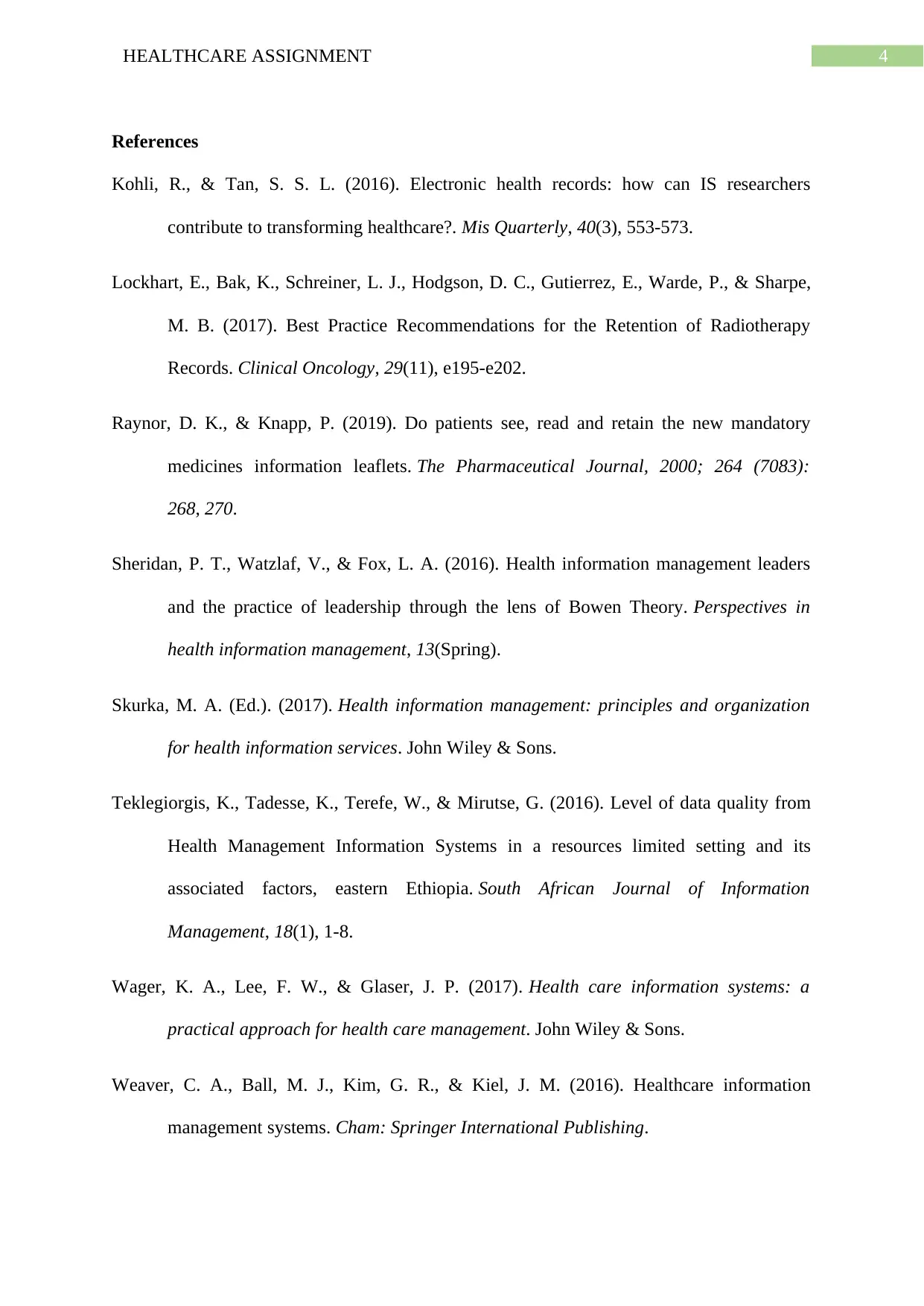
4HEALTHCARE ASSIGNMENT
References
Kohli, R., & Tan, S. S. L. (2016). Electronic health records: how can IS researchers
contribute to transforming healthcare?. Mis Quarterly, 40(3), 553-573.
Lockhart, E., Bak, K., Schreiner, L. J., Hodgson, D. C., Gutierrez, E., Warde, P., & Sharpe,
M. B. (2017). Best Practice Recommendations for the Retention of Radiotherapy
Records. Clinical Oncology, 29(11), e195-e202.
Raynor, D. K., & Knapp, P. (2019). Do patients see, read and retain the new mandatory
medicines information leaflets. The Pharmaceutical Journal, 2000; 264 (7083):
268, 270.
Sheridan, P. T., Watzlaf, V., & Fox, L. A. (2016). Health information management leaders
and the practice of leadership through the lens of Bowen Theory. Perspectives in
health information management, 13(Spring).
Skurka, M. A. (Ed.). (2017). Health information management: principles and organization
for health information services. John Wiley & Sons.
Teklegiorgis, K., Tadesse, K., Terefe, W., & Mirutse, G. (2016). Level of data quality from
Health Management Information Systems in a resources limited setting and its
associated factors, eastern Ethiopia. South African Journal of Information
Management, 18(1), 1-8.
Wager, K. A., Lee, F. W., & Glaser, J. P. (2017). Health care information systems: a
practical approach for health care management. John Wiley & Sons.
Weaver, C. A., Ball, M. J., Kim, G. R., & Kiel, J. M. (2016). Healthcare information
management systems. Cham: Springer International Publishing.
References
Kohli, R., & Tan, S. S. L. (2016). Electronic health records: how can IS researchers
contribute to transforming healthcare?. Mis Quarterly, 40(3), 553-573.
Lockhart, E., Bak, K., Schreiner, L. J., Hodgson, D. C., Gutierrez, E., Warde, P., & Sharpe,
M. B. (2017). Best Practice Recommendations for the Retention of Radiotherapy
Records. Clinical Oncology, 29(11), e195-e202.
Raynor, D. K., & Knapp, P. (2019). Do patients see, read and retain the new mandatory
medicines information leaflets. The Pharmaceutical Journal, 2000; 264 (7083):
268, 270.
Sheridan, P. T., Watzlaf, V., & Fox, L. A. (2016). Health information management leaders
and the practice of leadership through the lens of Bowen Theory. Perspectives in
health information management, 13(Spring).
Skurka, M. A. (Ed.). (2017). Health information management: principles and organization
for health information services. John Wiley & Sons.
Teklegiorgis, K., Tadesse, K., Terefe, W., & Mirutse, G. (2016). Level of data quality from
Health Management Information Systems in a resources limited setting and its
associated factors, eastern Ethiopia. South African Journal of Information
Management, 18(1), 1-8.
Wager, K. A., Lee, F. W., & Glaser, J. P. (2017). Health care information systems: a
practical approach for health care management. John Wiley & Sons.
Weaver, C. A., Ball, M. J., Kim, G. R., & Kiel, J. M. (2016). Healthcare information
management systems. Cham: Springer International Publishing.
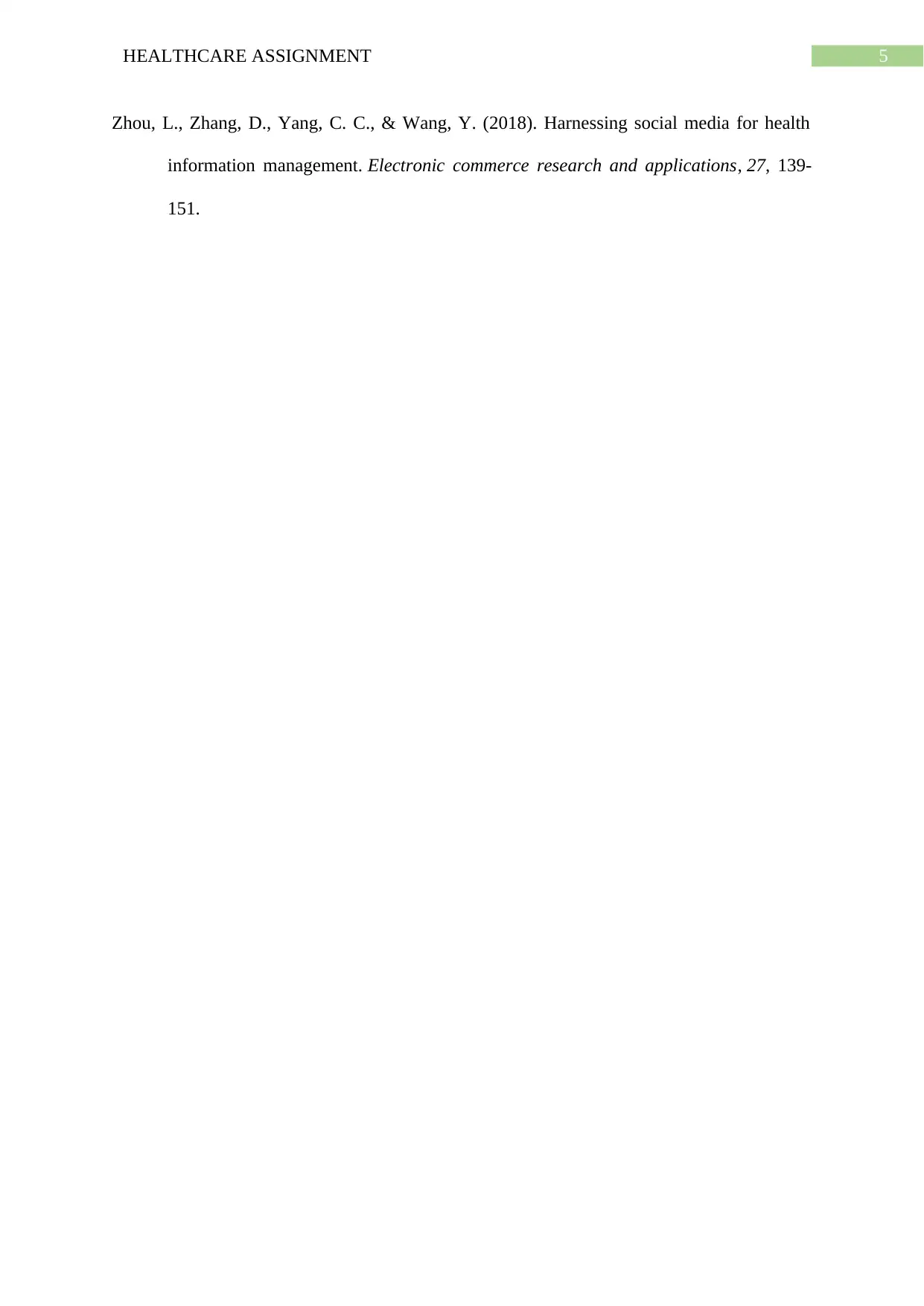
5HEALTHCARE ASSIGNMENT
Zhou, L., Zhang, D., Yang, C. C., & Wang, Y. (2018). Harnessing social media for health
information management. Electronic commerce research and applications, 27, 139-
151.
Zhou, L., Zhang, D., Yang, C. C., & Wang, Y. (2018). Harnessing social media for health
information management. Electronic commerce research and applications, 27, 139-
151.
⊘ This is a preview!⊘
Do you want full access?
Subscribe today to unlock all pages.

Trusted by 1+ million students worldwide
1 out of 6
Related Documents
Your All-in-One AI-Powered Toolkit for Academic Success.
+13062052269
info@desklib.com
Available 24*7 on WhatsApp / Email
![[object Object]](/_next/static/media/star-bottom.7253800d.svg)
Unlock your academic potential
Copyright © 2020–2025 A2Z Services. All Rights Reserved. Developed and managed by ZUCOL.




